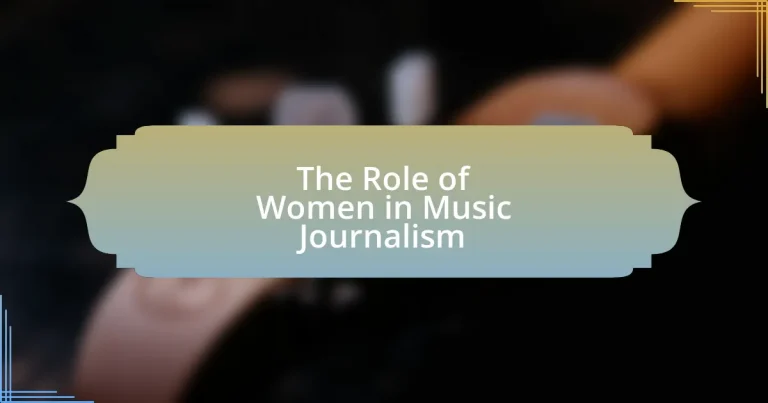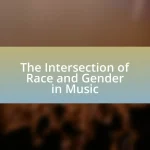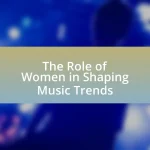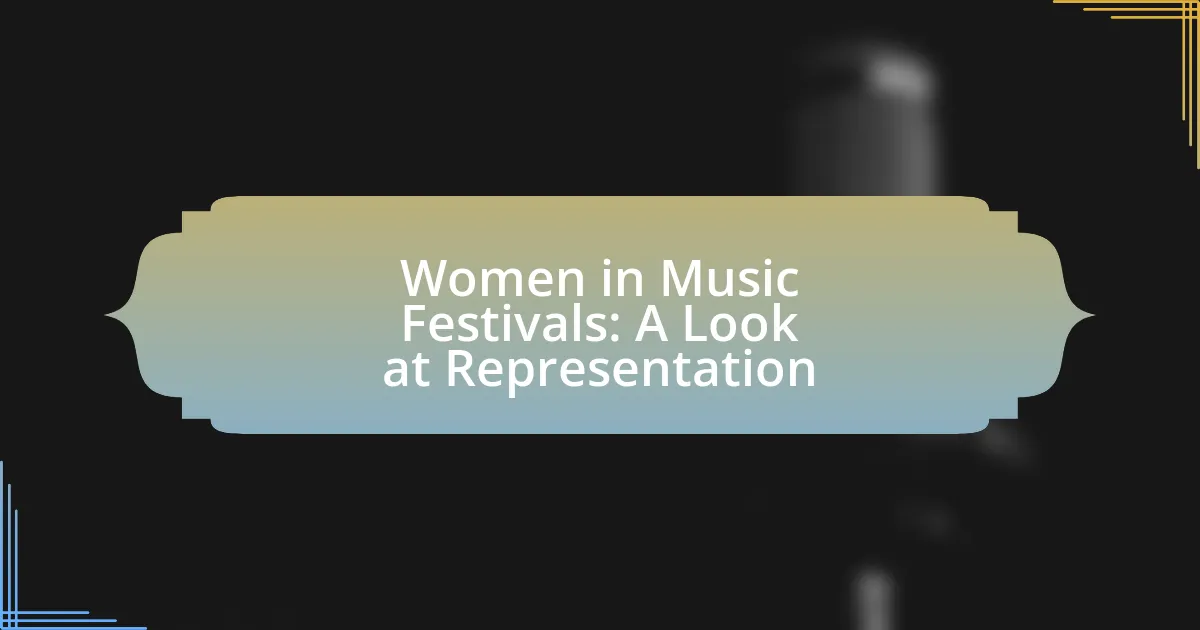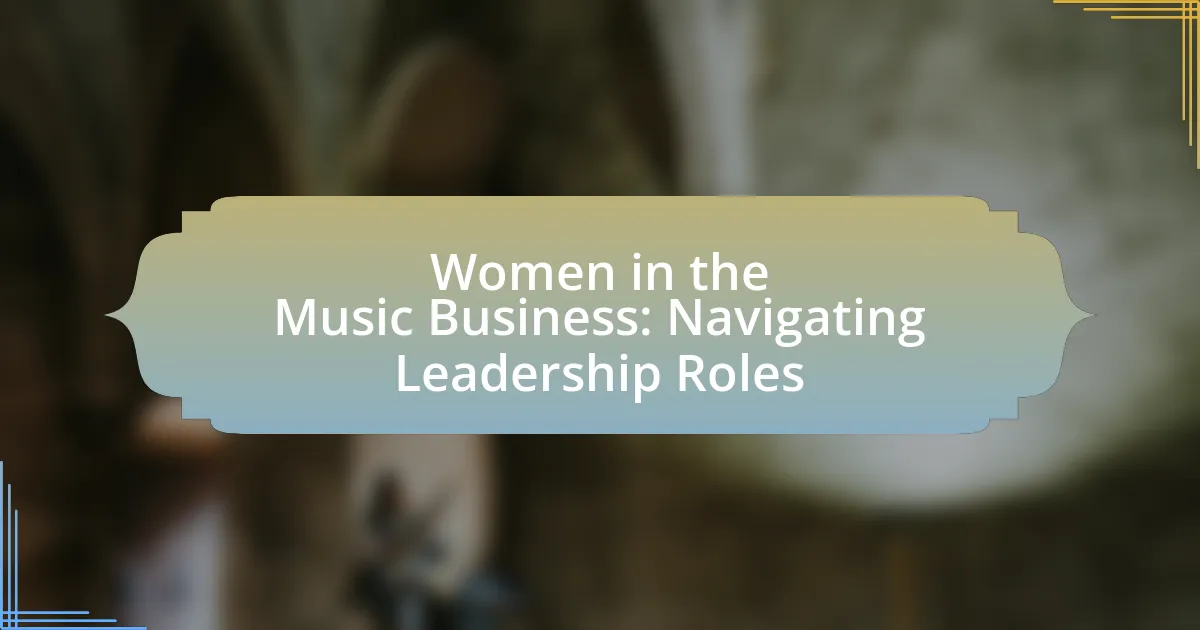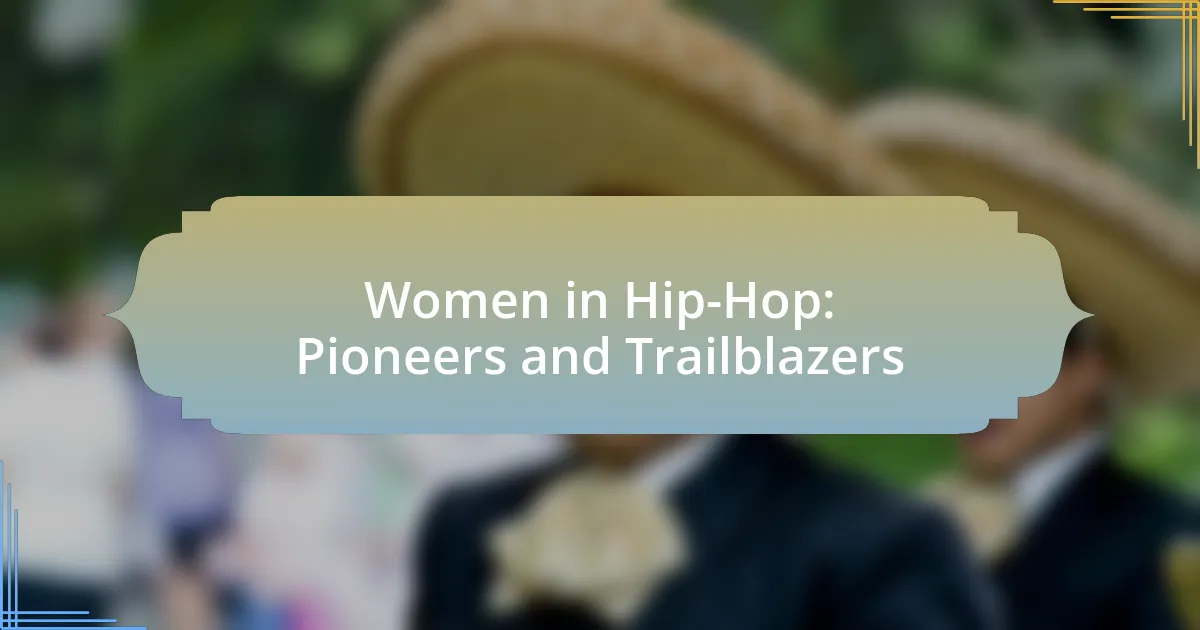The article examines the critical role of women in music journalism, highlighting their contributions to diverse perspectives, industry norms, and the amplification of underrepresented voices. It traces the evolution of women’s roles from marginalization to influential positions, addressing historical barriers such as gender discrimination and underrepresentation. The discussion includes the impact of female representation on music criticism, audience perception, and the challenges women face, including bias and harassment. Additionally, it outlines strategies for overcoming these challenges, the importance of mentorship and networking, and the unique themes women journalists explore in their writing.
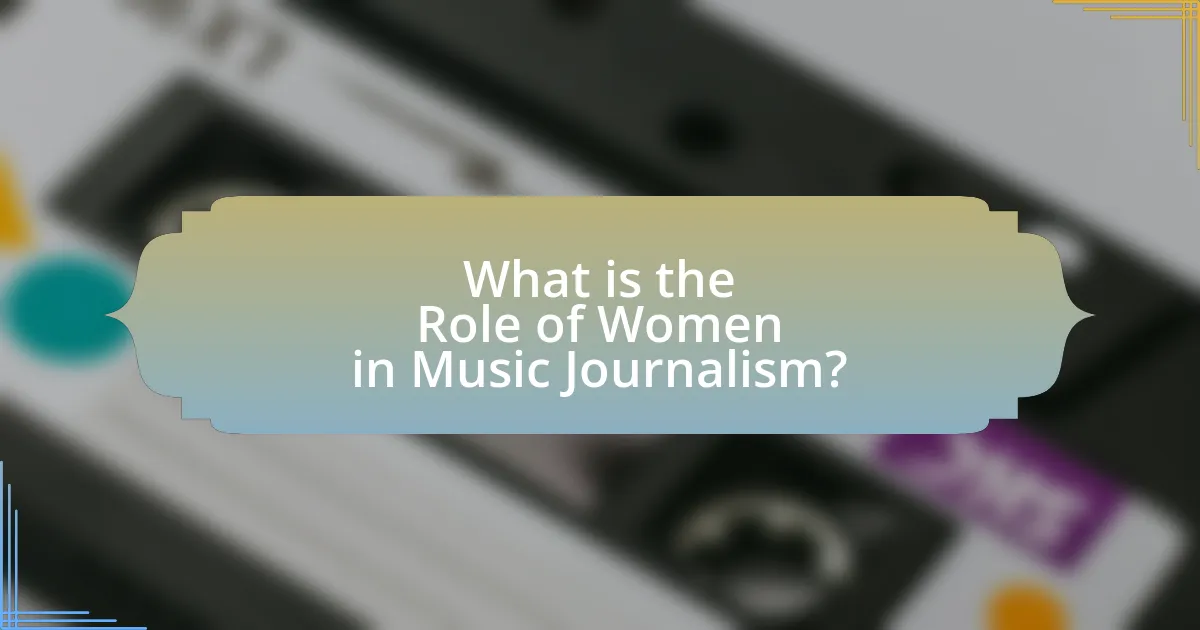
What is the Role of Women in Music Journalism?
Women play a crucial role in music journalism by providing diverse perspectives, challenging industry norms, and amplifying underrepresented voices. Their contributions have historically shaped music criticism, reporting, and cultural discourse, as evidenced by the increasing presence of women in prominent music publications and platforms. For instance, a study by the Annenberg Inclusion Initiative found that women comprised only 22.5% of music journalists in 2019, highlighting the ongoing need for gender equity in the field. Furthermore, women journalists often focus on issues such as gender representation in music, which fosters a more inclusive dialogue within the industry.
How has the role of women evolved in music journalism over time?
The role of women in music journalism has evolved significantly from being marginalized to becoming influential voices in the industry. Historically, women faced barriers to entry in journalism, often relegated to supportive roles or excluded from major publications. However, from the 1970s onward, women like Ellen Willis and Lisa Robinson began to gain recognition, paving the way for future generations. By the 1990s and 2000s, the rise of feminist music criticism and the emergence of online platforms allowed women to assert their perspectives more prominently. Today, women hold key editorial positions and contribute to diverse narratives in music journalism, reflecting a broader cultural shift towards inclusivity and representation. This evolution is evidenced by the increasing number of female critics and writers in major music publications, as well as the establishment of initiatives aimed at supporting women in the field.
What historical barriers have women faced in music journalism?
Women in music journalism have historically faced barriers such as gender discrimination, lack of access to opportunities, and underrepresentation in media outlets. Gender discrimination has often manifested in the form of biased hiring practices, where male candidates were favored over equally qualified female candidates. Additionally, women have frequently encountered challenges in gaining credibility and respect in a male-dominated industry, which has limited their ability to advance in their careers.
The lack of access to opportunities is evidenced by the fact that, until the late 20th century, most prominent music publications were predominantly staffed by men, which restricted women’s voices and perspectives in music criticism. Underrepresentation is further highlighted by statistics showing that women comprised only a small percentage of music journalists in major publications, reinforcing a cycle of exclusion. These barriers have contributed to a historical landscape where women’s contributions to music journalism have often been overlooked or undervalued.
How have women’s contributions shaped the music journalism landscape?
Women’s contributions have significantly shaped the music journalism landscape by introducing diverse perspectives, challenging industry norms, and amplifying underrepresented voices. Pioneering figures such as Ellen Willis and Ann Powers have not only critiqued music but also explored its cultural implications, thereby enriching the discourse around music. Research indicates that women’s writings have often focused on the intersection of music with social issues, which has broadened the scope of music journalism. For instance, the rise of feminist music criticism in the 1970s and 1980s highlighted gender disparities in the industry, leading to greater awareness and advocacy for equality. Additionally, contemporary journalists like Jessica Hopper and Amanda Petrusich continue to influence the field by addressing topics such as gender representation and the experiences of female artists, further solidifying women’s integral role in shaping music journalism.
Why is the representation of women important in music journalism?
The representation of women in music journalism is crucial for promoting diversity and inclusivity within the industry. This representation ensures that women’s voices, experiences, and perspectives are acknowledged and valued, which can lead to a more comprehensive understanding of music culture. Studies have shown that diverse teams produce better outcomes; for instance, a report by McKinsey & Company found that companies with higher gender diversity are 21% more likely to outperform their counterparts in profitability. Furthermore, the lack of female representation can perpetuate stereotypes and limit the narratives surrounding female artists, as evidenced by the underrepresentation of women in music reviews and critiques. Thus, increasing women’s representation in music journalism not only enriches the discourse but also fosters a more equitable environment in the music industry.
What impact does female representation have on music criticism?
Female representation significantly enhances music criticism by introducing diverse perspectives and challenging existing biases within the industry. Research indicates that when women are involved in music journalism, the narratives surrounding female artists become more nuanced and equitable, leading to a broader understanding of their contributions. For instance, a study published in the Journal of Popular Music Studies found that female critics are more likely to highlight the complexities of women’s experiences in music, which can counteract the often male-dominated viewpoints prevalent in traditional criticism. This shift not only enriches the discourse but also fosters a more inclusive environment that recognizes the value of diverse voices in shaping music narratives.
How does diversity in music journalism influence audience perception?
Diversity in music journalism significantly influences audience perception by providing a broader range of perspectives and narratives that resonate with varied demographic groups. When music journalism includes voices from different genders, ethnicities, and backgrounds, it challenges dominant narratives and fosters a more inclusive understanding of music culture. For instance, research by the Annenberg Inclusion Initiative found that women and people of color are often underrepresented in music journalism, which can lead to skewed representations of music genres and artists. This lack of diversity can result in audiences feeling alienated or misrepresented, while increased diversity can enhance relatability and engagement, ultimately shaping how audiences interpret and connect with music.
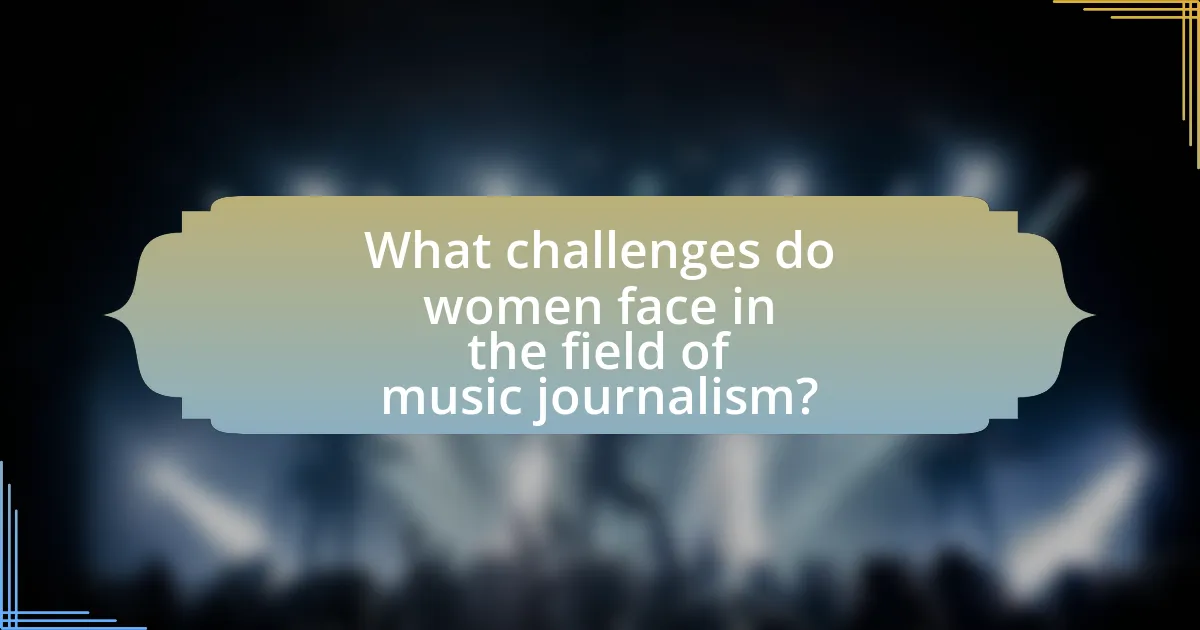
What challenges do women face in the field of music journalism?
Women in music journalism face significant challenges, including gender bias, underrepresentation, and harassment. Gender bias manifests in the form of skepticism regarding their expertise and authority, often leading to fewer opportunities for women compared to their male counterparts. Underrepresentation is evident in the lack of female voices in major publications and platforms, which limits diverse perspectives in music criticism and reporting. Additionally, harassment, both online and in-person, poses a serious threat to women in this field, discouraging many from pursuing or continuing their careers. According to a 2021 study by the Music Industry Research Association, 60% of women in music journalism reported experiencing harassment, highlighting the pervasive nature of this issue.
What are the common obstacles encountered by women in music journalism?
Women in music journalism commonly encounter obstacles such as gender bias, lack of representation, and limited access to industry networks. Gender bias manifests in the form of skepticism regarding their expertise and authority, often leading to their work being undervalued compared to their male counterparts. A study by the Annenberg Inclusion Initiative found that only 22% of music journalists are women, highlighting the lack of representation in the field. Additionally, women often face challenges in accessing industry networks that are predominantly male, which can hinder their career advancement and opportunities for collaboration. These factors collectively contribute to a challenging environment for women in music journalism.
How do gender biases manifest in music journalism?
Gender biases in music journalism manifest through the underrepresentation of women, stereotypical portrayals, and differential treatment in coverage. Research indicates that women journalists often face challenges in gaining equal visibility and credibility compared to their male counterparts, leading to a significant gender gap in bylines and recognition. For instance, a study by the Annenberg Inclusion Initiative found that only 22.4% of artists reviewed in major music publications were women, highlighting the systemic bias in coverage. Additionally, women are frequently pigeonholed into specific genres or roles, such as pop or singer-songwriter, while male journalists are more often associated with a broader range of genres, reinforcing stereotypes. This disparity in representation and treatment illustrates the pervasive nature of gender biases within the field of music journalism.
What role does workplace culture play in these challenges?
Workplace culture significantly influences the challenges faced by women in music journalism. A supportive and inclusive workplace culture can empower women, fostering collaboration and mentorship, which are crucial for career advancement. Conversely, a toxic or exclusionary culture can perpetuate gender biases, limit opportunities, and create hostile environments, ultimately hindering women’s professional growth. Research indicates that organizations with strong diversity and inclusion practices see improved employee satisfaction and retention rates, highlighting the importance of a positive workplace culture in addressing these challenges.
How can women overcome challenges in music journalism?
Women can overcome challenges in music journalism by actively seeking mentorship and networking opportunities within the industry. Establishing connections with experienced professionals can provide guidance and support, which is crucial in a field often dominated by male voices. Research indicates that mentorship significantly enhances career advancement for women, as noted in a study by the American Association of University Women, which found that women with mentors are more likely to achieve leadership roles. Additionally, women can leverage social media platforms to amplify their voices and showcase their work, thereby increasing visibility and access to opportunities. By participating in workshops and training programs focused on skills development, women can also enhance their expertise and confidence, further enabling them to navigate and succeed in the competitive landscape of music journalism.
What strategies can women employ to succeed in this field?
Women can succeed in music journalism by building a strong network, honing their writing skills, and leveraging social media for visibility. Establishing connections with industry professionals and fellow journalists can lead to mentorship opportunities and collaborations, which are crucial for career advancement. Developing a unique voice and style in writing helps women stand out in a competitive field, while actively engaging on platforms like Twitter and Instagram allows them to showcase their work and connect with a broader audience. Research indicates that women who actively participate in networking and self-promotion are more likely to secure influential positions in journalism, as highlighted in the study “Women in Journalism: A Global Perspective” by the International Women’s Media Foundation.
How can mentorship and networking support women in music journalism?
Mentorship and networking can significantly support women in music journalism by providing access to industry knowledge, resources, and professional connections. Mentorship offers guidance from experienced professionals, helping women navigate challenges and develop their skills in a male-dominated field. Networking facilitates relationships that can lead to job opportunities, collaborations, and visibility in the industry. For instance, a study by the Women’s Media Center in 2020 highlighted that women with mentors are more likely to advance in their careers and have increased confidence in their abilities. Additionally, organizations like Women in Music provide platforms for networking, which can enhance women’s representation and influence in music journalism.
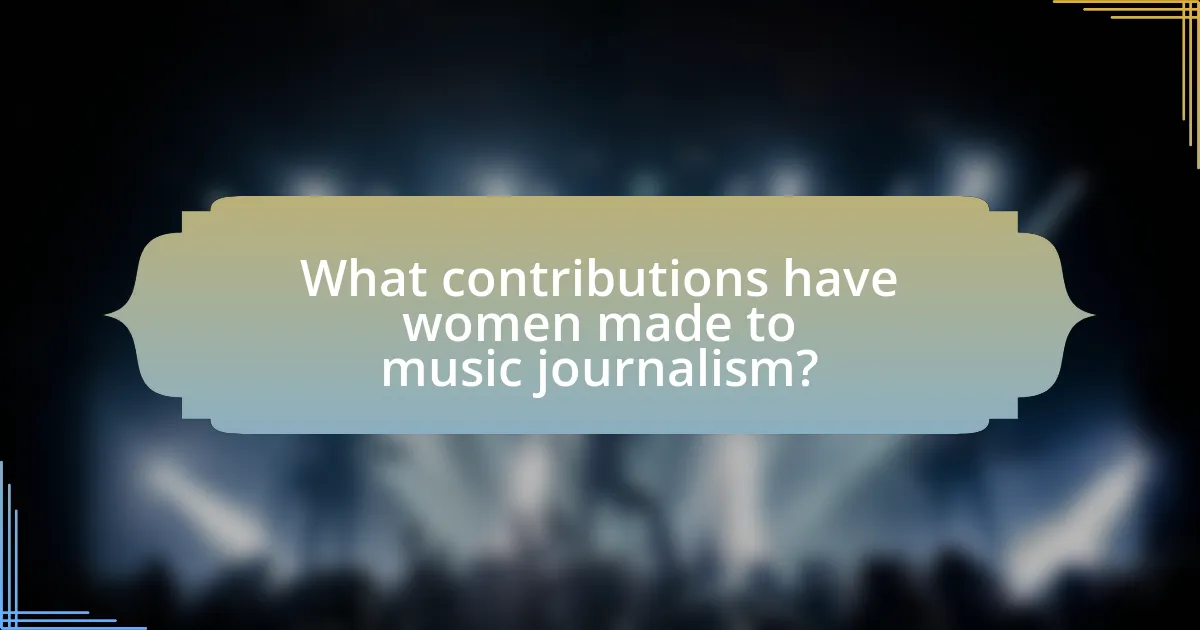
What contributions have women made to music journalism?
Women have significantly shaped music journalism by introducing diverse perspectives, advocating for underrepresented artists, and pioneering influential publications. Notable figures such as Ellen Willis, who wrote for The New Yorker and contributed to feminist discourse in music, and Ann Powers, a prominent critic for NPR, have expanded the narrative around music by focusing on gender and cultural issues. Additionally, women have founded key music publications, such as the feminist music magazine “Bitch,” which highlights women’s voices in the industry. Their contributions have not only enriched the field but have also led to greater visibility for female artists and marginalized communities within music.
What are some notable achievements of women in music journalism?
Women in music journalism have achieved significant milestones, including the establishment of influential publications and the breaking of gender barriers in a predominantly male industry. Notable achievements include the founding of major music magazines such as “Rolling Stone” by Jann Wenner, where women like Ellen Willis contributed as the first female rock critic, shaping music criticism. Additionally, women like Ann Powers and Jessica Hopper have gained recognition for their impactful writing and advocacy for diverse voices in music, with Powers serving as NPR Music’s critic and Hopper being a prominent figure in discussions about gender and representation in music. These contributions have not only elevated women’s voices in music journalism but have also influenced the broader cultural landscape.
Who are influential female music journalists and what are their impacts?
Influential female music journalists include Ann Powers, Jessica Hopper, and Nardine Saad, each significantly impacting the music industry through their writing and advocacy. Ann Powers, a critic for NPR, has shaped discussions around music and culture, emphasizing the importance of diverse voices in her critiques. Jessica Hopper, known for her work in publications like Pitchfork and The Village Voice, has been a strong advocate for women in music, highlighting gender issues and promoting female artists. Nardine Saad, a journalist for the Los Angeles Times, has focused on the intersection of music and social issues, bringing attention to underrepresented narratives in the industry. Their contributions have not only enriched music journalism but also fostered greater inclusivity and awareness within the music community.
How have women journalists changed the narrative in music coverage?
Women journalists have significantly changed the narrative in music coverage by amplifying diverse voices and perspectives that were previously marginalized. They have introduced a more inclusive approach to music criticism, focusing on underrepresented genres and artists, such as women, LGBTQ+ musicians, and artists of color. For instance, publications like Pitchfork and NPR Music have featured women writers who highlight the contributions of female artists, reshaping the discourse around gender in the music industry. This shift has led to increased visibility for female musicians and a broader understanding of music’s cultural impact, as evidenced by the rise in coverage of women-led festivals and initiatives aimed at promoting gender equality in music.
What unique perspectives do women bring to music journalism?
Women bring diverse and nuanced perspectives to music journalism, often highlighting underrepresented voices and experiences within the industry. Their unique viewpoints can challenge traditional narratives, focusing on themes such as gender equality, representation, and the intersectionality of race and culture in music. Research indicates that female music journalists are more likely to cover a broader range of genres and artists, including those from marginalized communities, which enriches the overall discourse in music criticism. For instance, studies show that women journalists often emphasize emotional and personal connections to music, providing insights that resonate with a wider audience. This approach not only diversifies the content but also fosters a more inclusive environment in music journalism.
How do women’s experiences influence their music critiques?
Women’s experiences significantly influence their music critiques by shaping their perspectives, emotional responses, and analytical frameworks. These experiences, which include cultural, social, and personal contexts, allow women to bring unique insights into the music they review. For instance, research indicates that women often highlight themes of empowerment, identity, and social justice in their critiques, reflecting their lived realities and societal challenges. A study published in the Journal of Popular Music Studies by authors such as Sarah Raine and Anna C. Houghton demonstrates that female critics frequently address gender dynamics in music, providing a critical lens that may differ from their male counterparts. This nuanced approach enriches music journalism by fostering diverse viewpoints and promoting inclusivity in the discourse surrounding music.
What themes do women journalists often explore in their writing?
Women journalists often explore themes of gender equality, representation, and social justice in their writing. These themes are prevalent as women in journalism seek to highlight the challenges and disparities faced by marginalized groups within the music industry. For instance, studies have shown that women journalists frequently address issues such as sexism, the underrepresentation of female artists, and the impact of cultural narratives on women’s experiences in music. This focus not only amplifies diverse voices but also contributes to broader discussions about equity and inclusivity in the arts.
What are best practices for aspiring women in music journalism?
Aspiring women in music journalism should focus on building a strong portfolio, networking effectively, and seeking mentorship. A robust portfolio showcases writing skills and diverse coverage, which is essential for attracting opportunities in a competitive field. Networking with industry professionals can lead to valuable connections and job prospects, as studies indicate that 70% of jobs are found through networking. Seeking mentorship from established journalists can provide guidance and insights into navigating challenges specific to women in the industry, as mentorship has been shown to enhance career advancement.
How can women build a strong portfolio in music journalism?
Women can build a strong portfolio in music journalism by actively contributing articles, reviews, and interviews to various platforms, including blogs, magazines, and online publications. Engaging with the music community through social media and networking events enhances visibility and credibility. Additionally, pursuing internships or freelance opportunities with established music outlets provides practical experience and exposure. According to a study by the Women’s Media Center, women represent only 38% of music journalists, highlighting the importance of increasing female voices in the field. By consistently producing quality content and leveraging available resources, women can effectively establish a robust portfolio in music journalism.
What resources are available for women pursuing careers in music journalism?
Women pursuing careers in music journalism can access various resources, including mentorship programs, professional organizations, and educational opportunities. Organizations such as the Women’s Audio Mission provide training and support specifically for women in audio and music fields. Additionally, the Association for Women in Music offers networking and professional development resources tailored to women in the industry. Educational institutions often have programs focused on music journalism, providing courses and workshops that equip women with the necessary skills. Furthermore, online platforms like She Shreds Magazine and Bitch Media highlight women’s voices in music journalism, offering writing opportunities and community support. These resources collectively empower women to navigate and succeed in the music journalism landscape.
